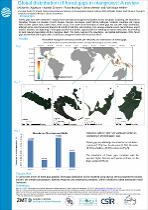JavaScript is disabled for your browser. Some features of this site may not work without it.
- ResearchSpace
- →
- Research Publications/Outputs
- →
- Conference Publications
- →
- View Item
| dc.contributor.author |
Agyekum, MK

|
|
| dc.contributor.author |
Zimmer, M

|
|
| dc.contributor.author |
Weerts, Steven P

|
|
| dc.contributor.author |
Helfer, V

|
|
| dc.date.accessioned | 2019-08-26T07:21:29Z | |
| dc.date.available | 2019-08-26T07:21:29Z | |
| dc.date.issued | 2019-07 | |
| dc.identifier.citation | Agyekum, M.K. et al. 2019. Global distribution of forest gaps in mangroves: A review. In: 5th international Mangrove Macrobenthos and Management meeting, Singapore, 1-5 July 2019 | en_US |
| dc.identifier.uri | http://hdl.handle.net/10204/11100 | |
| dc.description | Presented at: 5th international Mangrove Macrobenthos and Management meeting, Singapore, 1-5 July 2019 | en_US |
| dc.description.abstract | Forest gaps have been observed in tropical and sub-tropical mangrove ecosystems across the globe, including Panama, Papua New Guinea, the Dominican Republic, Australia, Florida, Malaysia, and French Guiana. However, no comprehensive survey of the global distribution of these gaps has been undertaken. Furthermore, the cause/s of gap formation is not fully understood, although in some cases it has been linked to the death of old trees (senescence) or to various episodic events (e.g. insect attacks, diseases, windthrows, and lighting). As yet, no attempt has been made to correlate gap distribution with environmental processes or extreme weather events. This study provides the state of knowledge on mangrove forest gap distribution based on a literature review and a global spatial survey using satellite imagery (ArcGIS and Google Earth). To evaluate the potential impact of those gaps on the mangrove ecosystems, we quantify the number of gaps and their area relative to the mangrove stands in which they occur. Using an approach derived from predictive habitat distribution models used in ecology, we examine how physico-chemical parameters (precipitation, temperature, salinity, and pH) or extreme weather events (lighting or storms) might drive the spatial distribution of forest gaps. The impact of forest gaps on mangrove ecosystem functioning has not been fully ascertained; gaps provide recruitment opportunities for seedlings to replace dead trees, thus leading to local natural regeneration that potentially has implications for the entire mangrove stand, the associated microbial and faunal communities, and the ecosystem processes that they drive. | en_US |
| dc.language.iso | en | en_US |
| dc.relation.ispartofseries | Workflow;22847 | |
| dc.subject | Forest gaps | en_US |
| dc.subject | Mangroves | en_US |
| dc.title | Global distribution of forest gaps in mangroves: A review | en_US |
| dc.type | Conference Presentation | en_US |
| dc.identifier.apacitation | Agyekum, M., Zimmer, M., Weerts, S. P., & Helfer, V. (2019). Global distribution of forest gaps in mangroves: A review. http://hdl.handle.net/10204/11100 | en_ZA |
| dc.identifier.chicagocitation | Agyekum, MK, M Zimmer, Steven P Weerts, and V Helfer. "Global distribution of forest gaps in mangroves: A review." (2019): http://hdl.handle.net/10204/11100 | en_ZA |
| dc.identifier.vancouvercitation | Agyekum M, Zimmer M, Weerts SP, Helfer V, Global distribution of forest gaps in mangroves: A review; 2019. http://hdl.handle.net/10204/11100 . | en_ZA |
| dc.identifier.ris | TY - Conference Presentation AU - Agyekum, MK AU - Zimmer, M AU - Weerts, Steven P AU - Helfer, V AB - Forest gaps have been observed in tropical and sub-tropical mangrove ecosystems across the globe, including Panama, Papua New Guinea, the Dominican Republic, Australia, Florida, Malaysia, and French Guiana. However, no comprehensive survey of the global distribution of these gaps has been undertaken. Furthermore, the cause/s of gap formation is not fully understood, although in some cases it has been linked to the death of old trees (senescence) or to various episodic events (e.g. insect attacks, diseases, windthrows, and lighting). As yet, no attempt has been made to correlate gap distribution with environmental processes or extreme weather events. This study provides the state of knowledge on mangrove forest gap distribution based on a literature review and a global spatial survey using satellite imagery (ArcGIS and Google Earth). To evaluate the potential impact of those gaps on the mangrove ecosystems, we quantify the number of gaps and their area relative to the mangrove stands in which they occur. Using an approach derived from predictive habitat distribution models used in ecology, we examine how physico-chemical parameters (precipitation, temperature, salinity, and pH) or extreme weather events (lighting or storms) might drive the spatial distribution of forest gaps. The impact of forest gaps on mangrove ecosystem functioning has not been fully ascertained; gaps provide recruitment opportunities for seedlings to replace dead trees, thus leading to local natural regeneration that potentially has implications for the entire mangrove stand, the associated microbial and faunal communities, and the ecosystem processes that they drive. DA - 2019-07 DB - ResearchSpace DP - CSIR KW - Forest gaps KW - Mangroves LK - https://researchspace.csir.co.za PY - 2019 T1 - Global distribution of forest gaps in mangroves: A review TI - Global distribution of forest gaps in mangroves: A review UR - http://hdl.handle.net/10204/11100 ER - | en_ZA |






